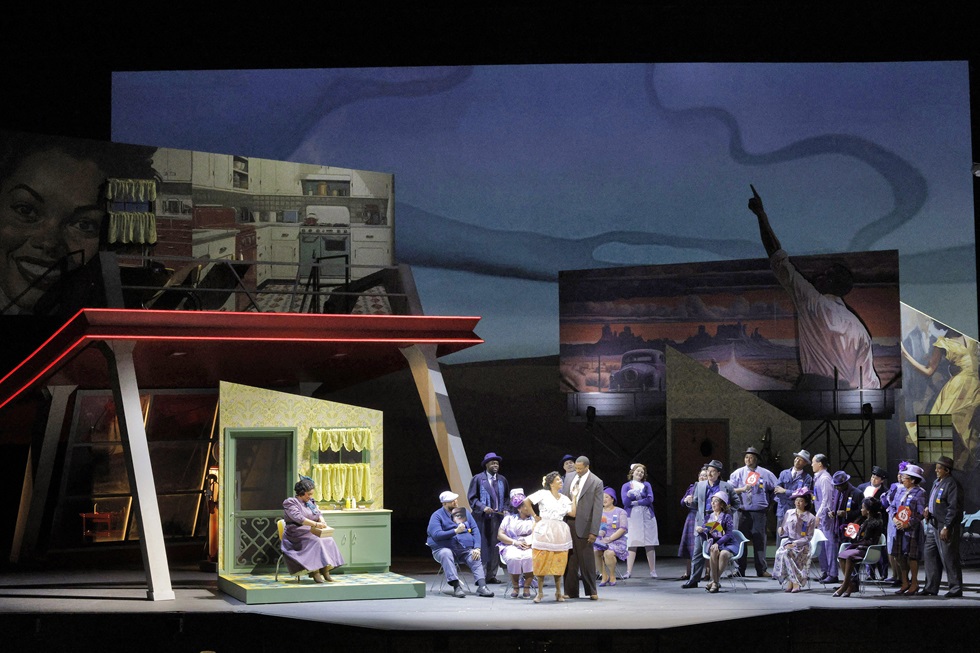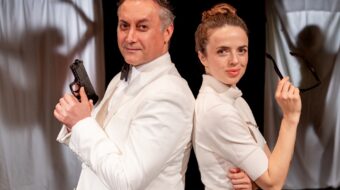
LOS ANGELES — Two hour-long one-act operas from the last century challenge viewers to adjust their thinking caps. It’s a double bill of African-American composer William Grant Still’s Highway 1, USA in a new company premiere production directed by Kaneza Schaal, and Austrian émigré Alexander Zemlinsky’s The Dwarf, a revival of Los Angeles Opera’s acclaimed 2008 production directed by Darko Tresnjak. The twin offering occupies the Dorothy Chandler Pavilion stage until March 17.
Audiences are sure to come away asking why American opera companies have turned their backs on these works until now.
Part of the reason is simply familiarity. In the first decade of the 21st century, LA Opera Music Director James Conlon promoted what he called the “Recovered Voices” project: fresh takes on works by Jewish and other composers whom the Nazis defined as non-Aryan or decadent, and banned. In the post-war years, as musical tastes changed and as the prewar history of such works had largely faded among operagoing audiences, these works by Zemlinsky, Franz Schreker, Walter Braunfels, Viktor Ullmann and others fell by the wayside, virtually forgotten. If they survived the Holocaust, such composers were unable to reestablish careers in exile. (Others notably did, of course: Erich Korngold, Arnold Schoenberg, Kurt Weill, among others.)
Revivals of those works, of whatever interest to scholars and some curious operagoers, did not, however, fill houses the way a Madame Butterfly or La Traviata often does.

Not yet ready to declare his efforts a thing of the past, Conlon has reconfigured his task to include the “recovered voices” of those, like Still, whose work was similarly neglected, owing to homegrown prejudice and outright racism. Still’s opera Troubled Island, with a libretto based on the Haitian Revolution begun by Langston Hughes and finished by Verna Arvey, was completed in 1939 but its premiere was delayed for a decade until 1949, when the adventurous New York City Opera produced it. Audiences took to it, but the big-city daily music critics largely panned it, unwilling to grant a success to a Black composer.
Highway 1, USA, composed in the 1940s, was not performed until the 1960s, and had to wait until 2021 for a fully staged major professional production, at Opera Theatre of St. Louis. LA Opera’s is only the second such production in the United States. Thus Still’s work legitimately also falls into the category of unjustly neglected works from the past. He was not so much an exile to America as an exile in America.
“Each of these operas,” says Christopher Koelsch, LA Opera’s president and CEO, “takes a unique approach to unrequited love and both stories are told through powerful, emotional music. I’m eager for Angelenos to experience these wonderful works.” On March 6, the night I attended, I noticed too many empty seats.
Highway 1, USA opens the evening. It’s the Los Angeles premiere—actually the West Coast premiere—even though the composer, “the dean of African-American composers,” made his home in L.A. from the 1930s until his death in 1978. It tells of a diligent Black couple, Bob and Mary, who live in a modest apartment connected to a gas station along the highway somewhere in the South on a major north-south route. Presumably the filling station has provided the family’s income for some years. The town is populated by a number of Black churchgoing families with warm affection for the hardworking, upright couple. Conflict in the opera stems from the promise Bob made to his mother before her death, that he would always protect and help his smart younger brother Nate, a college graduate with much promise but little ambition. The couple have scrimped and saved for Nate’s education and now, a year or more later, he still has not found work. It turns out Nate is also romantically attracted to Mary, but in the events surrounding his advances, Bob awakens to his brother’s parasitical nature. And from then on, the opera resolves hopefully, the couple now able to focus on building a better life for themselves.
Still resisted writing an opera suffused with “Negro” sensibilities and a score drenched in blues, jazz, and gospel. Elements of these appear, but the overwhelming sense is that the composer wanted to write a domestic opera with Black characters who could nevertheless represent America’s universal postwar striving for a comfortable middle-class life. In some ways, Still’s opera, written during the Jim Crow era, explores the earlier 20th-century Great Debate between Booker T. Washington’s accommodationist philosophy toward segregation and W.E.B. Du Bois’s call for no delay in implementing racial equality—a discussion of which, in connection with this opera, can be seen here.
The libretto is by Verna Arvey (1910-1987), an L.A.-born woman of Jewish parentage who was also an exceptional pianist who played some of Still’s compositions and later became his wife.
The leading roles of Bob and Mary are performed by baritone Norman Garrett, the Abdul in Omar in 2022, and soprano Nicole Heaston, who first appeared with LAO as Musetta in La Bohème in 2007. Tenor Chaz’men Williams-Ali sings the unsympathetic role of Nate. The cast also includes mezzo-soprano Deborah Nansteel as Aunt Lou and bass-baritone Alan Williams as the Sheriff, as well as a chorus with a couple of dozen members. In the cast also are two charming non-vocal, dancing spirits identified as Fox (Kiara Benn) and Hare (Cheyanne Williams), characters originally from African folklore who became standard in African-American folktales as B’rer Fox and B’rer Rabbit.
One could say that the opera as a whole is a contemporary folktale involving ordinary people and their struggle for decency, where love and the American dream win out in the end. Most producers, I imagine, would conceive of this work as more of a chamber opera for a smaller venue. It was courageous for LA Opera to mount it in the vast auditorium of the Dorothy Chandler. I hope it had the impact in the far reaches of the upper balconies that it did in the downstairs orchestra section. I would question the design decision to set the opera seemingly in the wide-open American West, with deserts and mesa mountaintops visible in the distance. The ethos of the Deep South drama does not seem appropriate for that Route 66 environment.
The creative team for Highway 1, USA reunites several artists from the company’s Omar: director Kaneza Schaal, production designer Christopher Myers, co-scenic designer Amy Rubin and lighting designer Pablo Santiago. They are joined by co-scenic designer Cheyanne Williams doing double duty, and costume designer Charlese Antoinette. Jeremy Frank is the chorus director.
An interview with director Kaneza Schaal can be viewed here. An informative interview with Aurelia Andrews, who collaborated with Opera Theatre of St. Louis on its 2021 production, can be viewed here.
Reimagining Velásquez
Art lovers will recall Diego Velásquez’s intriguing 1656 painting Las Meninas, depicting the five-year-old Infanta Margaret Theresa, a Spanish princess during the reign of King Philip IV, as the central figure amidst her entourage of ladies in waiting (per the title), other court figures, a dog, and a baroquely dressed dwarf, aside from a self-portrait of the artist at his easel. The painting served as inspiration for the story The Birthday of the Infanta by Oscar Wilde, which in 1922 Alexander Zemlinsky (1871-1942) adapted for the operatic stage as Der Zwerg (The Dwarf). It’s the princess’s 18th birthday and the court gathers to celebrate her. Exquisite presents—books textiles, jewels—await her. The most interesting one, however, comes from a sultan, a dwarf who emerges from his wicker cage speaking Spanish, spouting poetry, and singing glorious exotic romantic love songs, accompanying himself on the lute.
In those times, a dwarf—like the hunchback Rigoletto, also celebrated in opera—was mocked as a source of amusement, a kind of animal or house pet with a semi-human brain, incapable of higher feelings, emotions and sentiments, “a jest of cruel Nature.” As he displays his verbal and vocal gifts to the spoiled Infanta, she is intrigued and amused, which the social outcast confuses with love. He is heartbroken when for the first time he is given a mirror in which to see himself, and he dies of despair realizing that she has only been toying with him for the fun of it. As he succumbs, asking to hold the white rose she had given him, she scampers off to dance with her party guests.
The Dwarf is not only about little people, obviously. It is about our all too common failure to see the humanity in the “other.” Given the time and place, that could mean the Jew, the Muslim, the African, Asian or Indigenous person, the woman, the disabled, the immigrant. One could go on to a very long recitation, though it’s worth mentioning that like Zemlinsky later, Oscar Wilde too had been banned after his conviction and imprisonment for homosexuality, at least in the English-speaking countries. In translation, however, his influence continued: Zemlinsky himself wrote another opera based on Wilde, A Florentine Tragedy (also performed in LA Opera’s “Recovered Voices series”), and Strauss’s Salome was taken word for word as the libretto to one of the most iconic and mold-breaking operas of the 20th century.

In King Philip’s day, the “other” also meant the American Natives, the miners of his gold and silver, the African slaves in his colonies, the very source of the wealth on lavish display, not to mention the Muslims and Jews persecuted or expelled from Spain by the Inquisition. Zemlinsky himself, though intellectually stellar and a leading composer and conductor of his time, was quite short and not especially attractive. This particular story must have felt very personal. One of the young women he taught and courted was a music student, Alma Schindler, who was a head taller and left him to marry composer Gustav Mahler.
Zemlinsky was the brother-in-law of Arnold Schoenberg, advocate of the twelve-tone system in music, but remained more solidly among that group of post-Wagnerians who embraced the full late-Romantic idiom—composers such as Anton Bruckner, Richard Strauss, Mahler and Schreker. The score to The Dwarf, especially the music for the protagonist, is lush, heady, ecstatic, splendored, otherworldly, like some exotic import from the inscrutable East.
Tenor Rodrick Dixon returns to sing the title role, which he performed in LA Opera’s 2008 production. I remember the work well and can attest that Dixon’s voice is, if anything, better than ever. Plot-wise, the race of the tenor should logically be irrelevant to the role, but the fact that Dixon is African-American adds depth to our understanding of the “othering” phenomenon. Soprano Erica Petrocelli, who trained in LA Opera’s young artist program, performs the role of the princess, Donna Clara. The cast also includes bass Kristinn Sigmundsson as the court chamberlain Don Estoban and soprano Emily Magee as Ghita, Donna Clara’s favorite maid.
Aside from director Darko Tresnjak, the rest of the creative team features scenic designer Ralph Funicello, costume designer Linda Cho, lighting designer Pablo Santiago, chorus director Jeremy Frank, and choreographer Bill Burns.
Approximate running time for the twofer is just under three hours, including one intermission. A word to the wise: Unless your bladder insists otherwise, remain in the hall during intermission (or return to your seat early), and you can watch the union stagehands transform the set from a rural Southern filling station to the Spanish royal court.
One hour before each performance, Music Director James Conlon gives an illuminating talk about what you are about to experience in the opera house. Click here to read Maestro Conlon’s essay on the double bill. And you can read the digital program here. A brief essay concerning autobiographical aspects of Zemlinsky’s setting of The Dwarf can be read here.
Remaining performances of this double bill are March 9 and 14 at 7:30 p.m. and March 17 at 2 p.m. Tickets can be purchased online at LAOpera.org, by phone at 213.972.8001, or in person at the LA Opera box office at the Dorothy Chandler Pavilion (135 N. Grand Ave., Los Angeles 90012).
We hope you appreciated this article. At People’s World, we believe news and information should be free and accessible to all, but we need your help. Our journalism is free of corporate influence and paywalls because we are totally reader-supported. Only you, our readers and supporters, make this possible. If you enjoy reading People’s World and the stories we bring you, please support our work by donating or becoming a monthly sustainer today. Thank you!












Comments